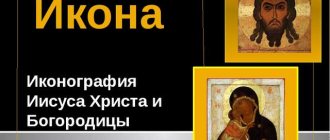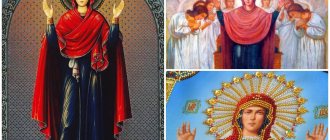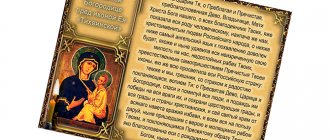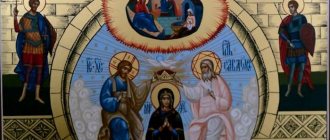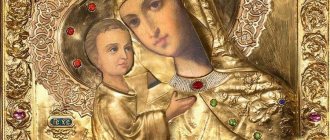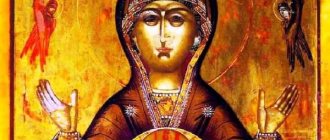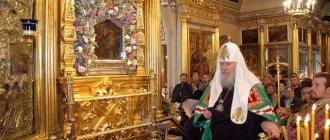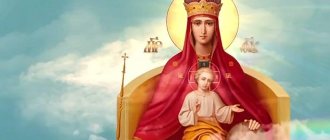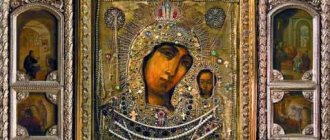Most Holy Theotokos, help us!
Every Christian trusts in the help of the Mother of God, turns to her in prayer, asks for the most dear, the most valuable. Who can measure the power of the love of the Blessed Virgin Mary for us, sinners and weaklings? This power surpasses human understanding - the Mother of God carried her Son to execution, to execution for our sins. We pray to the Lady, continuing to sin and crucify the Lord with our sins. And the Queen of Heaven never ceases to console us, encourage us, and heal us.
The Christian family has been given a great consolation - the belt of the Most Holy Theotokos. It was woven by the hands of the Most Pure One, entwined around the Holy Womb that bore God. This is material evidence of salvation left to help us.
Historical evidence
Two sources of the 10th century tell about the belt of the Blessed Virgin Mary and the Virgin Mary - the Minology of Basil II and the Synaxarion of the Byzantine Church.
According to the Minology, the robe and belt of the Mother of God were in Jerusalem. Then, under the emperor Arcadia, who ruled at the end of the 4th - beginning of the 5th century, they were transferred to Constantinople.
During the reign of Justin II (VI century), the belt was moved from the city of Zila to the Chalcopratian church in Constantinople. The shrine was placed in a golden ark, sealed with the royal seal of Emperor Arcadius.
THE HISTORY OF THE ACQUISITION OF THE HONORABLE BELT OF THE MOTHER OF GOD
The Belt of the Blessed Virgin Mary was one of the three main shrines of Constantinople, associated with the earthly life of the Mother of God; In addition to the Belt, the Robe (more precisely, maforium) of the Virgin Mary and the icon of the Mother of God Hodegetria, painted, according to legend, by the Evangelist Luke, were kept in Constantinople. There are two stories about the origin of the belt of the Virgin Mary, one of them in the Minology of Basil II, the other in the Synaxarion of the Church of Constantinople, both sources of the 10th century. According to legend, Saint Mary herself wove a belt from camel hair. According to one version, the Most Holy Theotokos, after Her Dormition, appeared to the Apostle Thomas and gave him the belt. As is known from the scriptures, the apostle did not make it in time for the burial of the Mother of God. To console the faithful disciple of Christ, She, through his prayers, handed over the shrine into his hands. According to the legend reflected in the Menology of Basil II, the Belt and Robe of the Mother of God, shortly before Her Dormition, were given to two pious Jerusalem widows and then passed on from generation to generation.
Miraculous gift of the Mother of God
Apostle Thomas, by God's providence, was not at the funeral of the Mother of God. He was very sad that he did not say goodbye to the Lady. As a consolation, the Most Holy Theotokos appeared to him and lowered her belt from heaven. This plot is found in Orthodox icons. In Greece, on Mount Athos, in the Dionysiates monastery there is a fresco from the 16th century. On it, Thomas holds out the Lady’s belt to the rest of the disciples, as if letting them admire it.
The fate of the shrine in the 21st century
After the conquest of Constantinople by the Turks, the belt was taken out and divided into parts. In the 21st century, parts of the shrine are located in different places - in Cyprus, Georgia and France, Belgium, the Netherlands and Italy. The most famous one is kept in the Vatopedi monastery on Mount Athos.
You can venerate the shrine in the Church of Elijah the Prophet in Obydensky Lane in Moscow, in the Trinity-Sergius Lavra and the Cathedral of the Kazan Icon of the Mother of God in St. Petersburg.
Chomsky relic
Apostle Thomas preached the Gospel in India. From there he was raptured to the Dormition of the Ever-Virgin Mary, and there he returned after Her Ascension. According to legend, it was in India that the belt of the Blessed Virgin Mary was kept for about four centuries. In 476, the shrine was hidden in the altar of the ancient Syrian church of Um al-Zunnar.
For many centuries the belt was considered lost. In 1953, an ancient scroll in Aramaic was discovered in the city of Mardin, located in Turkey. The document stated that the shrine was hidden in the altar of the Church of the Belt of the Virgin Mary in the city of Homs. To find it, many people and hierarchs gathered - Orthodox and other Christian communities.
A slab with an inscription in Aramaic was found under the altar: “This temple was founded in 59 AD.” Under the slab, a marble cube was discovered, and inside the cube was a silver ark, in which lay a folded woven belt made of camel hair, embroidered with gold threads, 60 centimeters long.
Scientists examined the find and confirmed that it is about a thousand years old. The relic became an object of worship, miracles were so frequent that an exhibition of crutches and prostheses that were no longer needed was assembled at the temple.
In 1982, a small part of the shrine was separated and donated to Christians in the Indian province of Malankari, where miraculous healings still occur to this day.
Since its discovery, the belt was kept in Homs, in a silver vessel in the shape of a flower with openwork petals, standing on a stand. During the war with ISIS, the belt was taken to a quieter area of the country. On August 15, 2014, the relic was returned to Homs in triumph.
The Church of the Belt of the Blessed Virgin Mary is not in Eucharistic communion with the Orthodox Church.
Vatopedi - custodian of the greatest Orthodox shrine
Vatoped
Part of the relic was kept by the Byzantine rulers. They went into battle with her. According to legend, a piece of the belt was kept in the cross, and the last of the Byzantine emperors who owned the shrine was Isaac II Angel), from whom the belt passed to the Bulgarian Tsar Ivan Asen, who defeated Isaac in battle. Then the relic went to the Serbian princes. The last owner, Prince Lazar, in the 14th century donated the belt to the Athos monastery of Vatopedi, where it is kept to this day.
Pilgrims testify to the subtle aroma that emanates from the shrine. The entire Orthodox world knows about miracles that constantly occur by the grace of God.
History of the origin of the relic
There are several versions of the origin of the sacred relic.
- Some legends say that the Virgin Mary wove it with her own hands using camel hair, and before her death she gave it to a righteous Christian family. The belt was passed down from generation to generation and ended up in the Cathedral of Constantinople only three centuries later. In the middle of the 10th century, Emperor Leo the First transferred the relic to the Blachernae Temple, where the miracle of the appearance of the Blessed Virgin took place.
- Another version of the origin of the relic is known from the tradition of Catholicism. Apostle Thomas did not take part in the burial of the Mother of God, since he was in the lands of India and preached about the Resurrection of Christ. Only three days after the death of the Sinless Virgin Mary, he arrived in holy Jerusalem. The Apostle, endlessly wanting to say goodbye to the Mother of God, tearfully asked to open the coffin. Amazement knew no bounds when the disciples of Christ, having removed the funeral slab from the tomb, did not find the body there. Only fragrant shrouds lay here. Kissing these fabrics, the apostles begged the Lord to reveal to them the secret of the disappearance of the Mother of God. The answer came soon: the bright spirit of the Virgin Mary appeared to them at the evening and greeted them, reassuring them with the words that She and God would forever be with the true believers.
- There is another legend that speaks of the appearance of the Heavenly Mother of God to Thomas on the third day of her repose. The Merciful Virgin, wanting to overcome the apostle’s sadness, threw her belt to him from heaven. The event found an echo in Orthodox iconography, and on the wall of one of the churches of Holy Athos there is a fresco that demonstrates the transfer of the relic by Thomas to the rest of the apostles, waiting for a miracle.
On the Orthodox belt icon, the Heavenly Mother of God, dressed in crimson fabrics, is depicted from the front, in her right hands she holds a red relic embroidered with gold thread. Two angels hover above the venerable head of the Most Pure Mother of God, chanting the name of the Lord. The canonical icon is close in style to the image called “The Intercession of the Mother of God”.
Finding of the Belt of the Blessed Virgin Mary by the Apostle Thomas
The image of the belt is also found on canvases where the Virgin hands over the shrine to Thomas, who bitterly mourns her death.
Important! The belt is a sacred relic from the time of the life of Mary; it heals various ailments, treats infertility and helps with birth complications.
Read about other icons of the Virgin Mary:
- Akhtyrskaya
- Bethlehem
- Sovereign
History of glorification
For nine centuries, the Belt of the Most Pure Mother of God was kept in a golden ark. In the 10th century, it was opened with the blessing of the Patriarch of the Church to heal the wife of Leo the Wise, Zoya, who was overcome by unclean spirits. One of the clergy had a vision that the relic would save the unfortunate woman from weakness the very moment she touched the Belt.
- All those present at the grand opening saw the incorruptibility of the shrine, which had lain for nine centuries. And indeed, Empress Zoe fully recovered when she felt the touch of the Belt of the Virgin Mary. In honor of the miraculous event, she ordered the relic to be embroidered with gold threads, and the holy confessor Euthymius composed a Word of Thanksgiving, performed during the services.
- In the same 10th century, the Belt of the Most Pure Mother of God was divided into three parts, which ended up at different times in monasteries in Bulgaria, Syria and Serbia. The largest fragments are kept in the Trooditissa monastery in Cyprus, as well as on Holy Mount Athos. A piece of the relic ended up in the lands of Georgia after Emperor Roman III allowed his daughter Elena to bring the shrine to the homeland of her husband Bagrat IV to strengthen the union.
- In the 14th century, the holy prince of Serbia, Lazar the First, gave the Vatopedi monastery the largest fragment of the Belt along with a particle of the Life-Giving Cross. Since that time, the relic has been kept in the caches of the central cathedral of the monastery complex. Therefore, the Vatopedi monks were nicknamed “Agiazonites,” which translated means “holy belts.” They took the shrine with them when they traveled to the island of Crete, the capital of Byzantium and Asia Minor. This was done with the aim of spreading the great grace emanating from the relic and uplifting the spirit of enslaved compatriots.
- In the middle of the 19th century, the shrine ended up in Constantinople, which was suffering from cholera. As soon as the ship with the relic approached the city’s harbor, the attack completely stopped, and the affected people escaped death. The Sultan became interested in the miraculous incident and invited the monks who accompanied the Belt to his own palace. Soon the shrine resurrected a recently deceased boy, whose father turned to the monks with a request for help.
- In 1894, the Belt arrived in one of the cities in Asia Minor, where the people prayed for deliverance from the locust attacks that were devastating crops and spoiling the fruits of trees. As the ship approached the harbor, thousands of these voracious insects darkened the sky and then were cast out into the open sea. The people who saw the miracle began to sing the hymn “Lord, have mercy!” The miracles performed by the relic are still performed today.
Miracles of new times
Evidence of miraculous accomplishments has been known to Christians since ancient times, and they continue to occur today. Prayers addressed to the Belt or to the icon with the image of the Most Pure Virgin resolve human troubles of various kinds. More often, gratitude comes from women who suffer from infertility and were able to give birth after sincere prayer, as well as from people who have suffered for a long time from a serious psychological or physical illness.
Icon Belt of the Blessed Virgin Mary
- The young man, four years after his marriage, discovered that he could not have children due to a congenital defect. Ten years later, he visited the sacred Vatopedi monastery and spent Holy Week here. The young man was inspired by stories about the miracles performed by the Belt of the Most Pure Mother of God, and decided to undergo a ritual of veneration of the relic. For a whole year he wore the consecrated belt given to him, and soon the doctors notified the couple that they would soon have a baby.
- The young woman sobbed inconsolably when she learned that doctors had given her a fatal diagnosis. The doctor advised to go to the hospital, but the operation was expensive, and the family did not have the necessary amount of money. The woman was reassured by her pious friend; she gave her a belt brought from Athos. The unfortunate woman tied the cloth at the place where the cancerous tumor was discovered and said that she sacredly believed in the omnipotence of the Lord and the Mother of God. On the day of the operation, an examination was carried out, but doctors did not find any violations. A great miracle of healing took place.
- In the middle of the 20th century, the population of the island of Thassos arrived at the Vatopedi monastery. They complained that for several years not a drop of water had fallen from the sky; such a drought gave rise to a terrible famine. People humbly asked the brethren to bring them the sacred Belt of the Mother of God. The Vatopedi monks set off on their journey two days later, as soon as the ship approached the harbor of Thassos, the people saw heavy rain approaching. A colossal storm raged on the island, which did not allow the brothers to descend to earth, so they sailed back, calmed by this miracle.
- The man was in a terrible car accident, doctors recorded broken bones, ruptures of internal organs and paralysis of the lower extremities. The doctor stated that there was practically no chance of healing. However, the man was a religious person from childhood and prayed non-stop for healing. He asked for help even in a dream in which he was on the top of a mountain, and the Belt of the Blessed Virgin appeared in the sky. The relic slowly descended to the ground and wrapped itself around the paralyzed legs. The next morning the man felt great hope for healing. After the necessary operation, the patient was able to move his legs and wiggle his toes, thanks to his great faith.
Position of the Belt of the Blessed Virgin Mary
Icon of the Position of the Belt of the Blessed Virgin Mary
The wife of the Constantinople emperor Leo VI the Wise, who reigned in 886-912, was tormented by demonic possession. The husband and relatives of the sick woman constantly prayed for the healing of Empress Zoe. After this, the woman had a revelation from above: she would recover if the belt of the Most Holy Theotokos was placed on her.
At that time, Euthymius II was the patriarch. The emperor asked to open the ark with the belt. The Patriarch removed the seal, opened the ark and took out the belt of the Queen of Heaven. With reverence, all those present kissed the perfectly preserved shrine, and then the patriarch spread it over the aching one. Immediately she felt completely healthy.
With joy and gratitude, all those involved praised the Lord and His Most Pure Mother. The healed empress personally embroidered the shrine with gold threads. The Patriarch composed a song of praise for the worship of the shrine. The belt was returned to the ark, sealed with the royal seal and a holiday was established in honor of the Most Glorious Mother of God in memory of the miracle that occurred from Her belt by the grace of our Lord Jesus Christ.
The solemnity of the Position of the Belt of the Blessed Virgin Mary is celebrated on September 13 according to the new style.
SOME OF THE MIRACLES THAT WERE REVEALED BY PRAYERS AT THE BELT OF THE VIRGIN
— 1871 An unusually severe outbreak of cholera occurred in Constantinople, which literally wiped out its inhabitants.
When the Belt was brought to the infected city, almost immediately after the arrival of the shrine, the epidemic receded. And people already infected with it were cured. At the same time, a case became known when the placing of the Belt of the Virgin Mary on a young man who had just died from a serious illness helped to resurrect him from the dead. — 1894 Getting rid of locusts that devoured crops in the city of Madita (Asia Minor). As soon as the ship with the shrine moored to the shore, the sky darkened with insects, which immediately began to fall into the water. Residents were saved from imminent famine. And also in 1915, crops in the Greek provinces were saved from a locust invasion. This time flocks of birds arrived and began to eat the pests.
— 1957 Elders arrived from an island near Athos to the Vatopedi monastery and asked the monks to save them from a terrible drought. A religious procession set out from the monastery with the holy Belt. As soon as the shrine appeared on the island, a heavy downpour began. In the Vatopedi Monastery, copies of the Belt are sewn and blessed, which women suffering from infertility wear on their wombs. Probably, the Mother of God hears fervent requests, so God’s grace, with the help of real faith and sincere prayers, descends through the shrine on childless spouses. The monastery houses a huge number of letters from happy people thanking God for the birth of a child.
— 2011 Archimandrite Ephraim, abbot of the Vatopedi monastery, brought an ark with a piece of the Belt of the Virgin Mary to our country. The shrine was put up for veneration in Moscow in the Cathedral of Christ the Savior, and immediately, from all over the country, pilgrims began to come for veneration. Despite the cold weather, a huge queue formed to worship at the Belt. Later, the ark visited some other Russian cities. During all this time, about three million were able to venerate the Holy Belt, which the Most Pure Virgin Mary held with Her hands. She blessed and helped a great many people, all who turned to Her with faith and hope for help and salvation.
Reverence
Pilgrims are constantly heading to Vatopedi, letters are arriving. They go to pieces of the shrine stored in different countries.
Service at the Vatopedi Monastery
People have great faith in the gracious power of the belt of the Blessed Virgin Mary. And indeed, miracles occur continuously - in spite of all diagnoses, infertile people conceive, the lame and crippled are healed, the mentally ill gain health, drunkards and drug addicts leave their addictions. There are no number of miracles that occurred during a difficult pregnancy or difficult childbirth. As a sign of gratitude, warmed by the miraculous help of the Queen of Heaven, Christians send letters and photographs of children as evidence of the miracle.
How to pray
To become a communicant of a miracle, it is not enough to simply tie a belt consecrated on the belt of the Most Holy Theotokos. It is best to contact your confessor, or, at the very least, any priest who will advise a prayer rule for the period of wearing the shrine. It would be right for the duration of the prayerful feat to undergo a feasible fast - to give up entertainment, marital intimacy, and possibly savory food.
The consecrated belt can be placed in the holy corner.
Before kissing the shrine, you should pray - say the Archangel greeting “Virgin Mother of God, rejoice,” or sing the troparion and kontakion of the Position of the Belt of the Most Holy Theotokos. Position of the Holy Belt of the Blessed Virgin Mary
